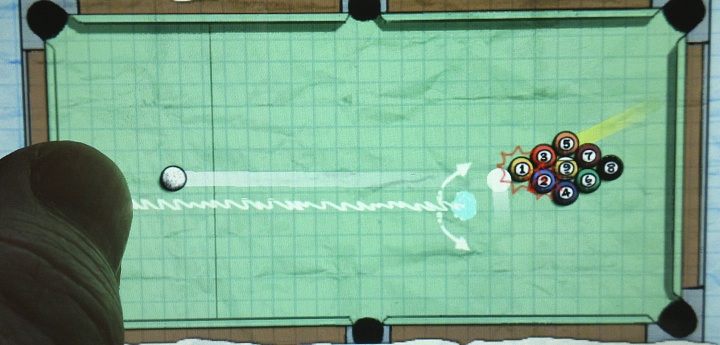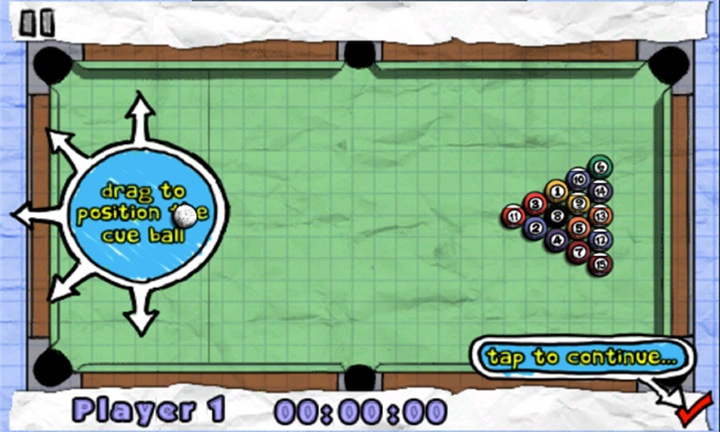Review: Doodle Pool
Score:
61%
I have to confess that I'm something of a connoisseur of pool games on handhelds and smartphones, running firstly on my Palm Tungsten T3 early in the last decade and then on my Symbian smartphones. I've played more frames of virtual pool on handheld devices than you've had hot dinners. Discarding any prejudice about the cartoon 'look' of Doodle Pool, what really matters is whether it's a great pool game or not.
Version Reviewed: 1.6
Buy Link | Download / Information Link
The game choices are familiar, even rather cutely portrayed in 'handdrawn' style - the two '8 ball' variants (what we're used to calling "pool" in the UK) and '9 ball', which is a lot more challenging in every way and the true pool variant for the purists. Well, in my opinion anyway, I've been playing handheld '9 ball' for years!

There's an impressive seven levels of computer AI, ranging from 'Baby' to 'Demon' - the former will let you play a full game while still learning the interface, while the latter will often only give you one chance to clear the table. Miss and the AI will clear up.

The first time into Doodle Pool, you're asked to pot three balls in tutorial style, showing you the basics of aiming and cueing. This works well, especially since the controls are different to every other pool game I've ever tried. Which isn't a criticism. Essentially, shots are aimed by drawing a vector on the table, i.e. a starting point ("touch here" in the screenshot below) and then dragging to one side to represent the direction and power with which you are 'drawing back' the cue. Don't worry, this is a lot more intuitive than it sounds.

Here's the aiming system in action. As you draw back your finger along the vector, the cue ball's path is indicated, along with the initial expected vector of the ball with which it will first come into contact. If you followed the 9 Ball link above, you'll know that in this case the balls have to be potted in numerical order - in case the number isn't uppermost once the balls have rolled around a bit, the next ball to be potted is always indicated with a cartoonish star pattern, with the subsequent ball having a less exagerated pattern. Enough to plan ahead, at least.

Although the system does generally work well, and the shaded expected paths often stop short of the appropriate pocket, the fact that the path of the 'object ball' is shown at all is a bit disappointing, since it does, ultimately, make Doodle Pool too easy - there's little incentive to 'learn' striking angles or work out where you should aim the cue ball, since it's all handed to you on a plate. And there's no way to turn object ball indication off.
All of which is a little dismissive in terms of helping you improve your computer pool skills. Worse is to come in that there's also no way to apply spin of any kind to the cue ball. Whether in the real world game or in a computer game, being able to add back spin or top spin is such a crucial part of any positional play that I'm amazed there's no facility for it here. As a result, every shot is 'full ball' and apart from the overall pace of the cue ball, there's very little chance to influence where it ends up, ready for your next pot. Disappointing.
Although I coped with the general 'doodle' graphics, the explosion of stars every time I potted a ball seemed over the top. Cute in the tutorial, a novelty for the first frame and then intensely irritating every time after that.

Caveats above, the touch control of shot taking was at least straightforward, if a little fiddly. Having dragged out the intended shot vector, and with the object ball line hovering over the appropriate pocket, you've then got to lift your finger without any change whatsoever in the positioning on-screen. This is tricky (and determined by the resolution of the grid of capacitive sensors in your phone's display), but just about possible sitting down in an office - on the move, on a bus ride, placing a shot accurately will be just about impossible.
What's needed, of course, is a more traditional two-stage process of aiming (and adjusting) and then tapping a 'shoot' button or similar. After all, when replacing the cue ball after an in-off or at the start of a game, a simple drag and then a tap to 'continue' is used.

In Doodle Pool's defense, the gameplay is (to a limited degree) fun, and the physics of ball contacts and motion around the table very realistic. I did feel the animation frame rate was a little low, I've seen smoother motion on pool games on Symbian handsets with processors a tenth as powerful - I suspect there's a graphics engine getting in the way here.
In the 'Time trial' and 'Shot in the Dark' modes there are two extra ways to try the game (the latter, in case you're wondering, fades the screen to black if you take too long on aiming up a shot), plus there's a 'pass around' 'Two player' mode - no sign of Bluetooth or online play, sadly. The latter, in particular, might have been Doodle Pool's saving grace.
I'm not saying that Doodle Pool's not an interesting Windows Phone game, I'm not saying that it's not well programmed - after all, it resumes more or less impeccably after being interrupted (e.g. by turning the screen off or pressing the Home button). But with such limited shot control it was always going to fall short for me, a confirmed handheld pool game fan. A title, then, for casual players only.
Reviewed by Steve Litchfield at
